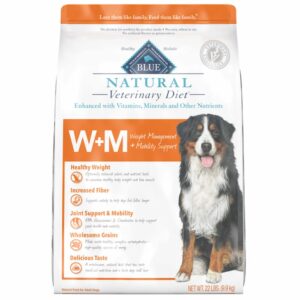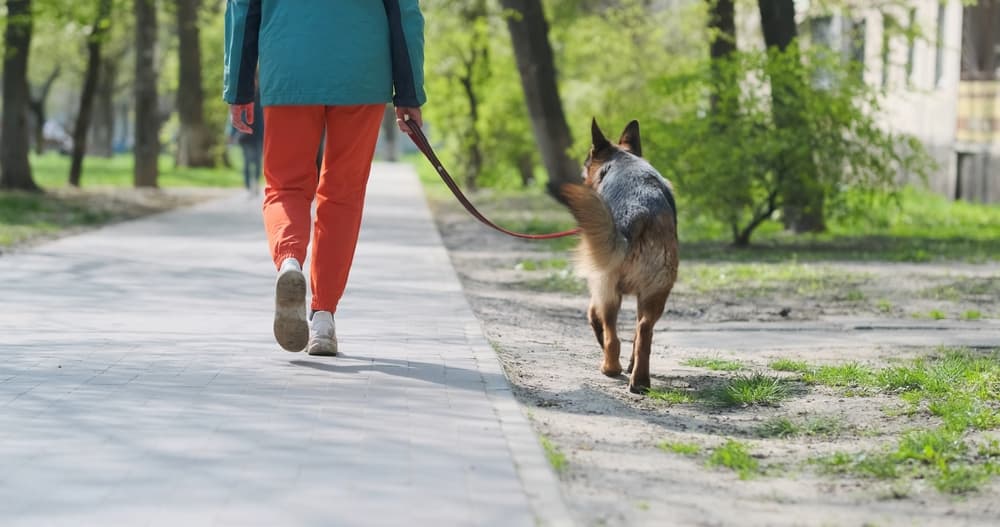Why Is My Dog Walking Slow?

All featured products are chosen at the discretion of the GreatPetCare editorial team and do not reflect a direct endorsement by the author or reviewer.
Your dog used to race for the door the moment you clipped the leash to their collar. On walks, you sometimes raced to keep up or admonished “slow down!” as your dog galloped down the sidewalk, eager to move from one mailbox and garden planter to the next as fast as possible.
If your former speed-walking pup has shifted into low gear, you’re probably wondering, “Why is my dog walking slow?” Let’s explore some potential reasons why your dog is slowing down on walks lately.
Why Is My Dog Walking Slow? 5 Potential Reasons
A dog walking slowly might not be an immediate cause for concern: Some dogs simply like to explore at their own pace and take in their surroundings.
“The pace that a dog walks varies: Some dogs tend to have more energy and walk at a faster pace while others prefer to move at a slower speed,” explains Kim DiMaio, VMD, veterinarian and owner of MainStreetVet.net in Perkiomenville, Pennsylvania. “Breed and individual temperament can play a role in each dog’s preferred pace and there is no one-size-fits-all [walking pace].”
But if you’re worried about your dog slowing down on walks, especially if the behavior seems unusual for them, consider the following factors:
Age
Puppies have an almost boundless energy, which translates to walking at a brisk pace and zigzagging across the path to catch all of the smells. But dogs naturally slow down as they age, notes Danny Cox, DVM, chief veterinary medical officer of Petzey. Most senior dogs walk at a much slower pace than puppies.
“As dogs age, their muscles and joints may weaken or become less flexible,” Dr. Cox says. “This natural aging process can result in a slower pace due to reduced strength, endurance and joint mobility.”
Joint pain
Dogs with osteoarthritis tend to take shorter walks and walk at a slower pace (1). In addition to shorter, slower walks, dogs with arthritis or joint pain might experience stiffness, limping, loss of muscle mass, and low energy. If you notice your dog walking slow and stiff or your dog arching their back and walking slow, your dog is likely in some kind of pain.
Dr. DiMaio adds that dogs in pain might be reluctant to jump or use stairs. “Arthritis is a very common cause of dogs moving at a slower pace. Pain can cause a dog to slow down to try to avoid movement that worsens pain.”
If your dog is diagnosed with arthritis, your veterinarian can recommend an individualized treatment plan. This may include a combination of pain medications (NSAIDs), joint supplements (e.g., Dasuquin, Cosequin), weight loss, and appropriate exercise.


Excess weight
A brisk walk can be difficult for an overweight dog. According to a 2022 survey conducted by the Association for Pet Obesity Prevention, 59 percent of dogs are considered overweight or obese (2). Dr. Cox notes that excess weight can strain a dog’s joints, muscles and cardiovascular system, making a walk more challenging. It might be one of the reasons a dog keeps stopping on walks or a dog keeps sitting on walks.
“As weight increases, it can become more challenging for a dog to keep an active pace,” Dr. DiMaio adds.
If your dog needs to lose weight, work with your veterinarian to come up with a weight management plan. This may include reducing the number of treats, eliminating table scraps, carefully measuring each meal, feeding a weight loss diet (e.g., Royal Canin Satiety Support, Hill’s Metabolic Weight Management, BLUE Natural Weight Management + Mobility Support) and appropriate low-impact exercises.



Health issues
A number of medical conditions, such as heart disease, respiratory problems or neurological disorders, can impact a dog’s energy levels and ability to walk briskly, according to Dr. Cox.
“Just like in people, when a dog isn’t feeling 100 percent, their activity level can go down as they try to rest their body,” Dr. DiMaio adds. “Various health conditions can cause lethargy, and one visible sign of this can be a decrease in activity level.”
Look for other signs that a dog might be dealing with health issues, such as loss of appetite, vomiting, diarrhea, being wobbly, circling, or increased respiratory rate while resting. If your dog is walking slowly with their head or tail down, looks weak, or shows other concerning symptoms, see your veterinarian.
Fear or anxiety
Unfamiliar surroundings, specific phobias, past trauma, and other factors can make dogs feel fearful or anxious, Dr. Cox notes. These feelings might cause dogs to walk at a slower pace because they’re on high alert and assessing their environment for potential threats.
Scared and anxious dogs might also look for opportunities to hide on a walk, slowing their pace to avoid potentially scary stimuli.
“Dogs who are experiencing fear or anxiety often give other signs in their body language such as averting their gaze, holding their ears back, hiding, panting, or even growling or barking,” says Dr. DiMaio.
If your dog is stressed, talk to your veterinarian about calming aids or prescription medications that may help.
Dog Walking Slow: Next Steps

An occasional slow, sniffing walk is no big deal. However, if your dog was once at the front of the pack during walks but has started walking slower, keeps stopping or sitting on walks, or refuses to walk altogether, it’s cause for concern.
“Consider whether their pace or behavior is out of character,” Dr. DiMaio advises. “If you feel that something has changed with your dog’s behavior, schedule a visit with their primary care veterinarian to have them evaluated.”
While there is no harm in allowing a dog to stop and enjoy all the sights and scents on a walk, Dr. DiMaio notes that dogs who are walking slowly due to distractions, not underlying health issues, may benefit from harnesses and leashes that can help direct their attention ahead of them to make it easier for them to maintain a reasonable walking pace.
Dogs who are diagnosed with health conditions might benefit from veterinarian prescribed or recommended medications and supplements. Once their health conditions are well-managed, dogs may resume their normal walking speed.
But dogs who have chronic conditions like arthritis that may result in a slower walking speed should be allowed to move at their own pace.
“It’s important to allow a slow-walking dog to take their time, especially if the pace is due
to age, discomfort, or health issues,” Dr. Cox says. “Forcing a quicker pace can exacerbate underlying conditions or cause stress.”
Other Tips and Advice
Exercise is important for a dog’s physical and mental health. Snapping on a leash and going for a walk might be the easiest option, but there are other activities to introduce when dogs can no longer make it around the block or don’t show interest in walks.
Swimming: It’s an ideal exercise for overweight dogs or dogs with joint issues.
Scent games: Hide treats and let your dog sniff them out. It’ll get your dog moving and provide essential mental stimulation.
Training: Teach older dogs new tricks to get them working their bodies and their brains.
Remember, regular check-ups are crucial for monitoring your dog’s health and addressing potential health issues proactively, so they can continue to enjoy regular walks—even if they are at a slower pace.
References
- Belshaw, Zoe et al. “Slower, shorter, sadder: a qualitative study exploring how dog walks change when the canine participant develops osteoarthritis.” BMC veterinary research vol. 16,1 85. 10 Mar. 2020, doi:10.1186/s12917-020-02293-8
- 2022 Pet Obesity Prevalence Survey. Association for Pet Obesity Prevention. Retrieved from https://www.petobesityprevention.org/2022









